Abstract
Hematopoietic stem cells (HSC) are unique in that they give rise both to new stem cells (self-renewal) and to all blood cell types. The cellular and molecular events responsible for the formation of HSC remain unknown mainly because no system exists to study it. Embryonic stem (ES) cells were induced to differentiate by coculture with the stromal cell line RP010 and the combination of interleukin (IL) 3, IL-6, and F (cell-free supernatants from cultures of the FLS4.1 fetal liver stromal cell line). Cell cytometry analysis of the mononuclear cells produced in the cultures was consistent with the presence of PgP-1+ Lin- early hematopoietic (B-220- Mac-1- JORO 75- TER 119-) cells and of fewer B-220+ IgM- B-cell progenitors and JORO 75+ T-lymphocyte progenitors. The cell-sorter-purified PgP-1+ Lin- cells produced by induced ES cells could repopulate the lymphoid, myeloid, and erythroid lineages of irradiated mice. The ES-derived PgP-1+ Lin- cells must possess extensive self-renewal potential, as they were able to produce hematopoietic repopulation of secondary mice recipients. Indeed, marrow cells from irradiated mice reconstituted (15-18 weeks before) with PgP-1+ Lin- cell-sorter-purified cells generated by induced ES cells repopulated the lymphoid, myeloid, and erythroid lineages of secondary mouse recipients assessed 16-20 weeks after their transfer into irradiated secondary mice. The results show that the culture conditions described here support differentiation of ES cells into hematopoietic cells with functional properties of HSC. It should now be possible to unravel the molecular events leading to the formation of HSC.
Full text
PDF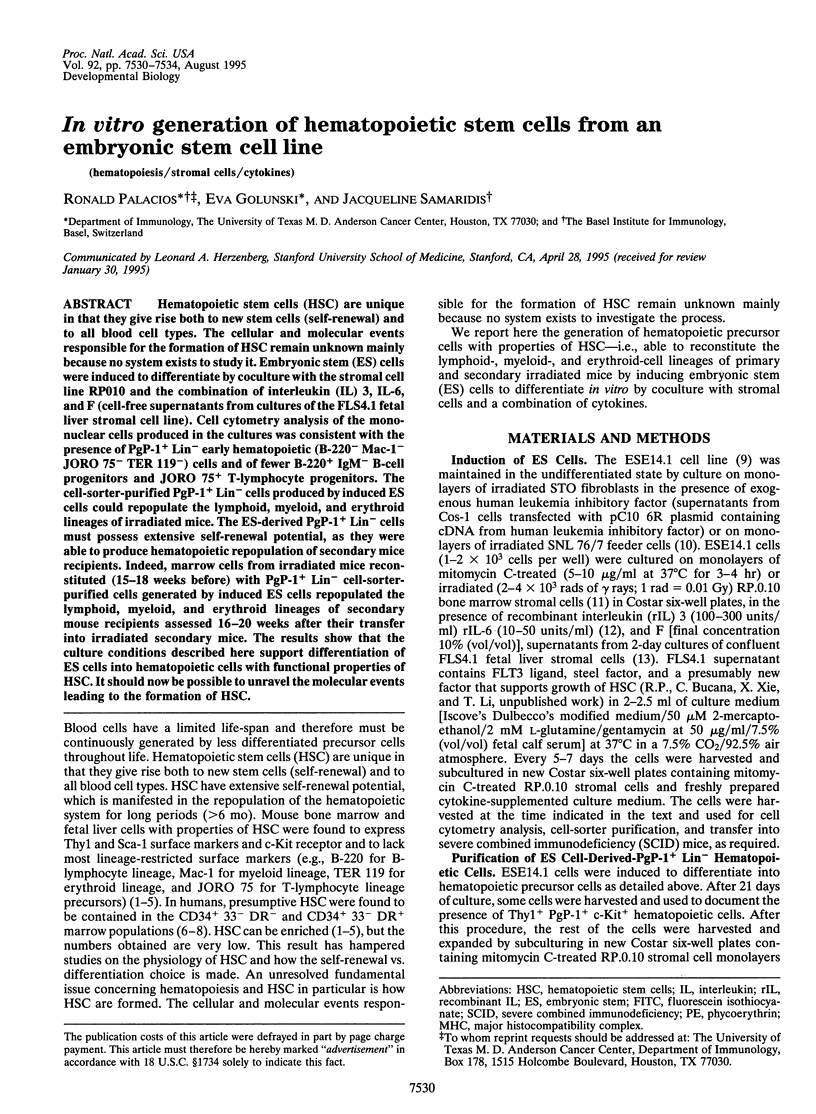
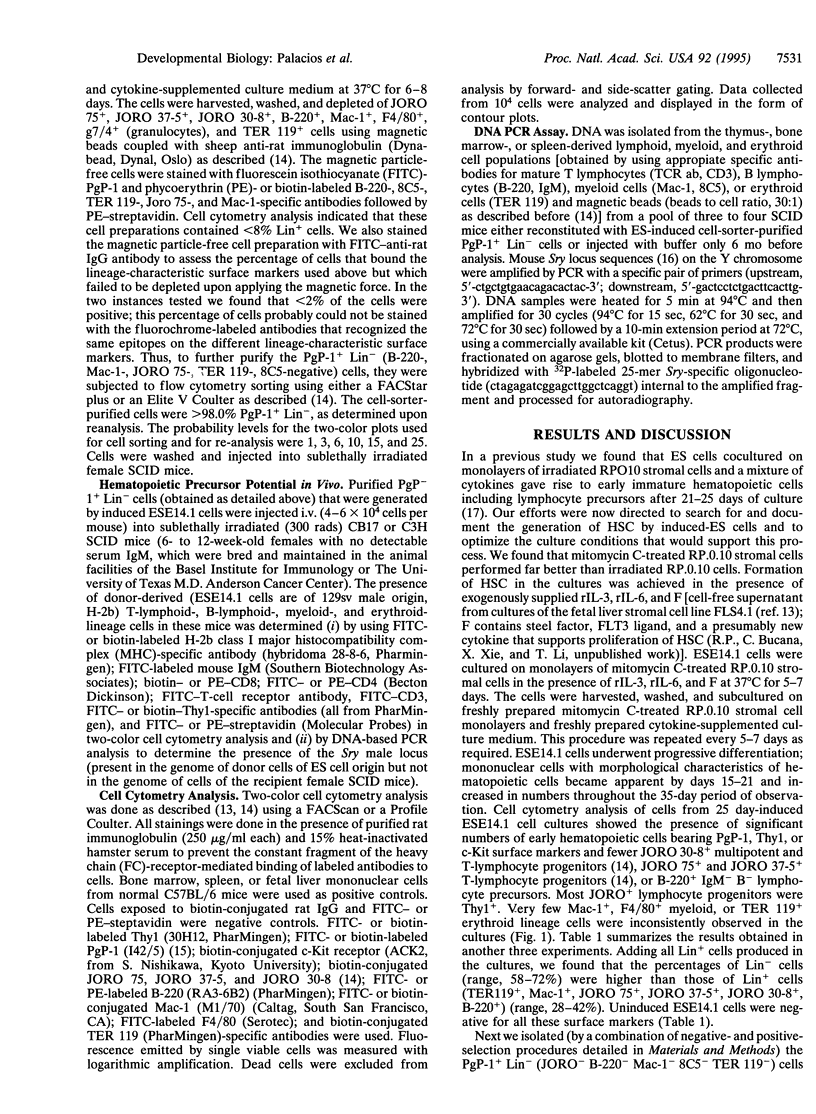
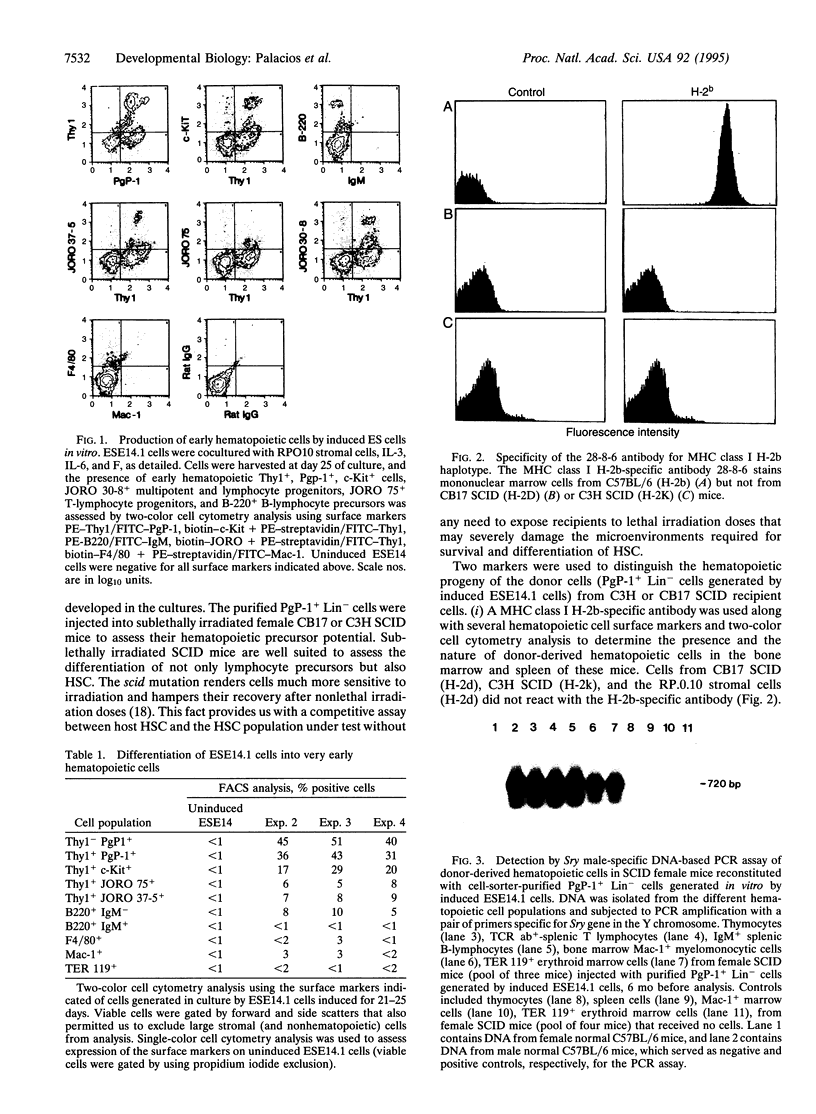
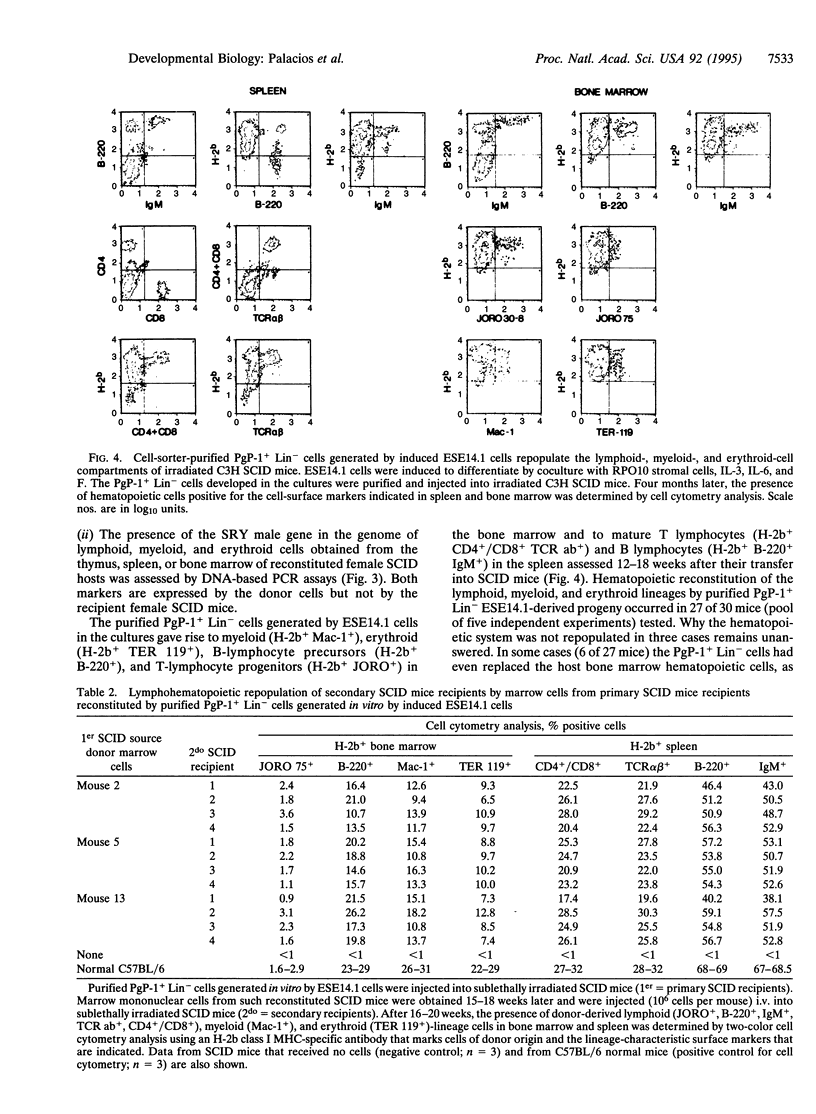
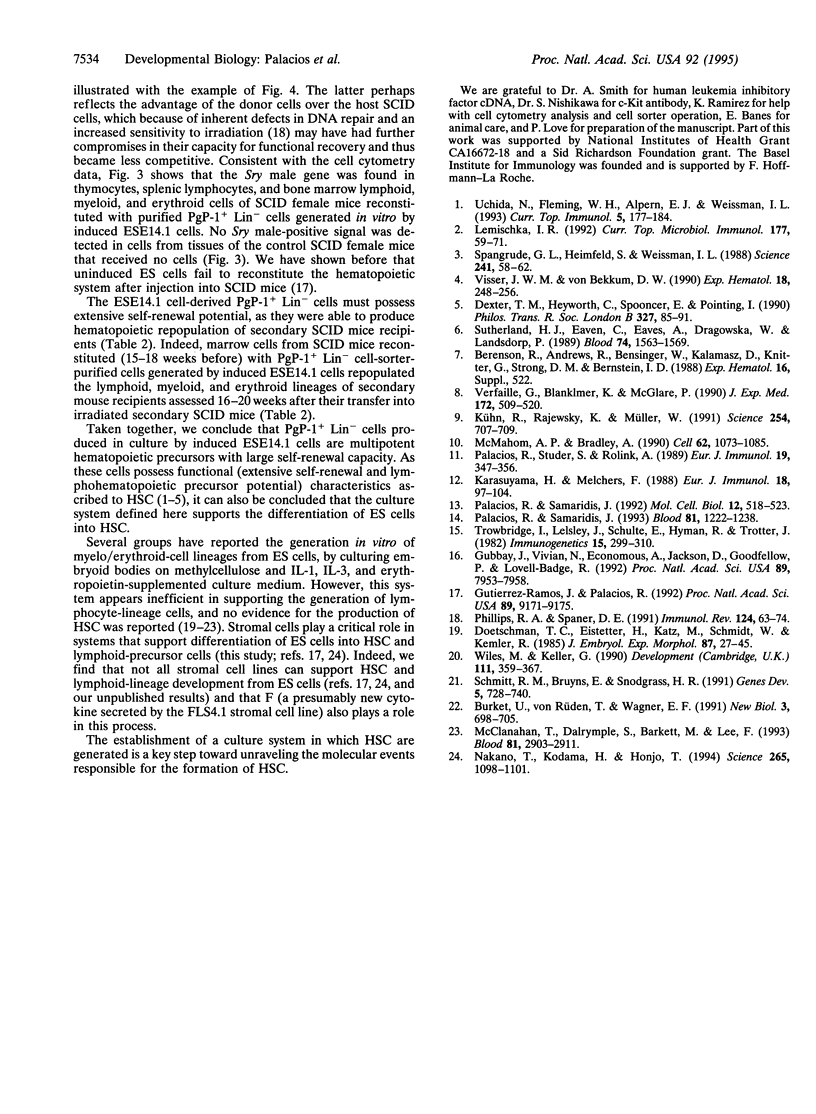
Images in this article
Selected References
These references are in PubMed. This may not be the complete list of references from this article.
- Burkert U., von Rüden T., Wagner E. F. Early fetal hematopoietic development from in vitro differentiated embryonic stem cells. New Biol. 1991 Jul;3(7):698–708. [PubMed] [Google Scholar]
- Doetschman T. C., Eistetter H., Katz M., Schmidt W., Kemler R. The in vitro development of blastocyst-derived embryonic stem cell lines: formation of visceral yolk sac, blood islands and myocardium. J Embryol Exp Morphol. 1985 Jun;87:27–45. [PubMed] [Google Scholar]
- Gubbay J., Vivian N., Economou A., Jackson D., Goodfellow P., Lovell-Badge R. Inverted repeat structure of the Sry locus in mice. Proc Natl Acad Sci U S A. 1992 Sep 1;89(17):7953–7957. doi: 10.1073/pnas.89.17.7953. [DOI] [PMC free article] [PubMed] [Google Scholar]
- Gutierrez-Ramos J. C., Palacios R. In vitro differentiation of embryonic stem cells into lymphocyte precursors able to generate T and B lymphocytes in vivo. Proc Natl Acad Sci U S A. 1992 Oct 1;89(19):9171–9175. doi: 10.1073/pnas.89.19.9171. [DOI] [PMC free article] [PubMed] [Google Scholar]
- Karasuyama H., Melchers F. Establishment of mouse cell lines which constitutively secrete large quantities of interleukin 2, 3, 4 or 5, using modified cDNA expression vectors. Eur J Immunol. 1988 Jan;18(1):97–104. doi: 10.1002/eji.1830180115. [DOI] [PubMed] [Google Scholar]
- Kühn R., Rajewsky K., Müller W. Generation and analysis of interleukin-4 deficient mice. Science. 1991 Nov 1;254(5032):707–710. doi: 10.1126/science.1948049. [DOI] [PubMed] [Google Scholar]
- Lemischka I. R. What we have learned from retroviral marking of hematopoietic stem cells. Curr Top Microbiol Immunol. 1992;177:59–71. doi: 10.1007/978-3-642-76912-2_5. [DOI] [PubMed] [Google Scholar]
- McClanahan T., Dalrymple S., Barkett M., Lee F. Hematopoietic growth factor receptor genes as markers of lineage commitment during in vitro development of hematopoietic cells. Blood. 1993 Jun 1;81(11):2903–2915. [PubMed] [Google Scholar]
- McMahon A. P., Bradley A. The Wnt-1 (int-1) proto-oncogene is required for development of a large region of the mouse brain. Cell. 1990 Sep 21;62(6):1073–1085. doi: 10.1016/0092-8674(90)90385-r. [DOI] [PubMed] [Google Scholar]
- Nakano T., Kodama H., Honjo T. Generation of lymphohematopoietic cells from embryonic stem cells in culture. Science. 1994 Aug 19;265(5175):1098–1101. doi: 10.1126/science.8066449. [DOI] [PubMed] [Google Scholar]
- Palacios R., Samaridis J. Bone marrow clones representing an intermediate stage of development between hematopoietic stem cells and pro-T-lymphocyte or pro-B-lymphocyte progenitors. Blood. 1993 Mar 1;81(5):1222–1238. [PubMed] [Google Scholar]
- Palacios R., Samaridis J. Fetal liver pro-B and pre-B lymphocyte clones: expression of lymphoid-specific genes, surface markers, growth requirements, colonization of the bone marrow, and generation of B lymphocytes in vivo and in vitro. Mol Cell Biol. 1992 Feb;12(2):518–530. doi: 10.1128/mcb.12.2.518. [DOI] [PMC free article] [PubMed] [Google Scholar]
- Palacios R., Stuber S., Rolink A. The epigenetic influences of bone marrow and fetal liver stroma cells on the developmental potential of Ly-1+ pro-B lymphocyte clones. Eur J Immunol. 1989 Feb;19(2):347–356. doi: 10.1002/eji.1830190220. [DOI] [PubMed] [Google Scholar]
- Phillips R. A., Spaner D. E. The scid mouse: mutation in a DNA repair gene creates recipients useful for studies on stem cells, lymphocyte development and graft-versus-host disease. Immunol Rev. 1991 Dec;124:63–74. doi: 10.1111/j.1600-065x.1991.tb00616.x. [DOI] [PubMed] [Google Scholar]
- Schmitt R. M., Bruyns E., Snodgrass H. R. Hematopoietic development of embryonic stem cells in vitro: cytokine and receptor gene expression. Genes Dev. 1991 May;5(5):728–740. doi: 10.1101/gad.5.5.728. [DOI] [PubMed] [Google Scholar]
- Spangrude G. J., Heimfeld S., Weissman I. L. Purification and characterization of mouse hematopoietic stem cells. Science. 1988 Jul 1;241(4861):58–62. doi: 10.1126/science.2898810. [DOI] [PubMed] [Google Scholar]
- Sutherland H. J., Eaves C. J., Eaves A. C., Dragowska W., Lansdorp P. M. Characterization and partial purification of human marrow cells capable of initiating long-term hematopoiesis in vitro. Blood. 1989 Oct;74(5):1563–1570. [PubMed] [Google Scholar]
- Trowbridge I. S., Lesley J., Schulte R., Hyman R., Trotter J. Biochemical characterization and cellular distribution of a polymorphic, murine cell-surface glycoprotein expressed on lymphoid tissues. Immunogenetics. 1982 Mar;15(3):299–312. doi: 10.1007/BF00364338. [DOI] [PubMed] [Google Scholar]
- Uchida N., Fleming W. H., Alpern E. J., Weissman I. L. Heterogeneity of hematopoietic stem cells. Curr Opin Immunol. 1993 Apr;5(2):177–184. doi: 10.1016/0952-7915(93)90002-a. [DOI] [PubMed] [Google Scholar]
- Verfaillie C., Blakolmer K., McGlave P. Purified primitive human hematopoietic progenitor cells with long-term in vitro repopulating capacity adhere selectively to irradiated bone marrow stroma. J Exp Med. 1990 Aug 1;172(2):509–502. doi: 10.1084/jem.172.2.509. [DOI] [PMC free article] [PubMed] [Google Scholar]
- Visser J. W., Van Bekkum D. W. Purification of pluripotent hemopoietic stem cells: past and present. Exp Hematol. 1990 Mar;18(3):248–256. [PubMed] [Google Scholar]



